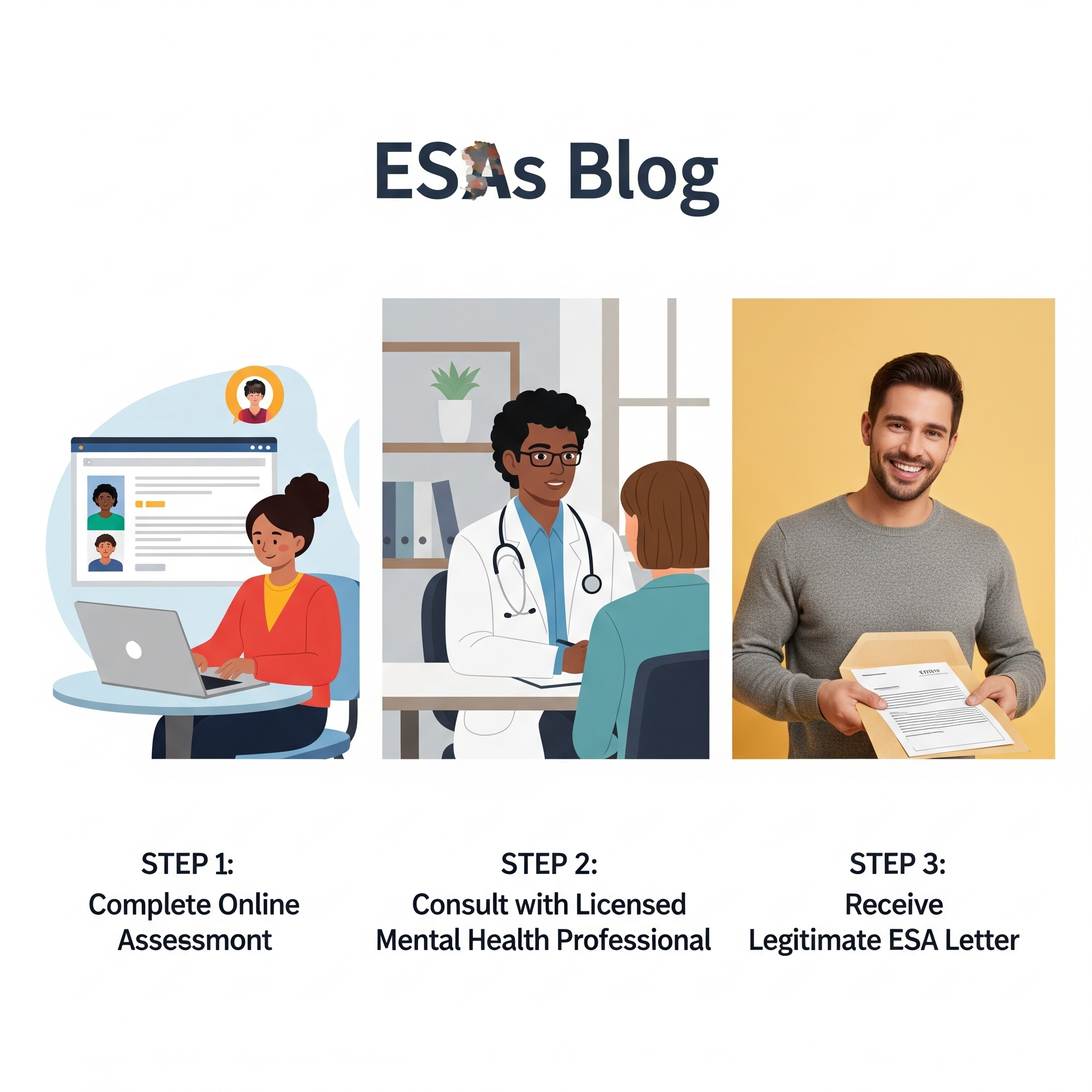For individuals relying on a Psychiatric Service Dog (PSD) for mental health support, air travel can sometimes feel like a complex maze of regulations. Unlike emotional support animals (ESAs), which no longer have automatic public access rights on planes, PSDs are recognized service animals under the Air Carrier Access Act (ACAA) and are generally permitted to fly in the cabin with their handlers at no additional charge. However, airlines have specific requirements to ensure the safety and comfort of all passengers.
At CertifyESA, we understand the critical role your PSD plays in your well-being. While we primarily focus on providing legitimate ESA and PSD letters from licensed mental health professionals for housing and general understanding, we also believe in empowering you with accurate information about air travel. This comprehensive guide will outline what major airlines typically require when flying with a PSD, helping you prepare for a smooth and stress-free journey.
—
The Foundation: The Air Carrier Access Act (ACAA) and Psychiatric Service Dogs
The Air Carrier Access Act (ACAA) is a federal law that prohibits discrimination by air carriers on the basis of disability (Air Carrier Access Act, 1986). Under this act, a service animal is defined as a dog, regardless of breed or type, that is individually trained to do work or perform tasks for the benefit of a qualified individual with a disability, including a psychiatric disability.
Key protections under the ACAA for PSD handlers include:
- In-Cabin Travel: PSDs are generally permitted to travel in the aircraft cabin with their handler, free of charge.
- No Breed Restrictions: Airlines cannot impose breed restrictions on service dogs.
- No Weight Limits (within reason): While a PSD must fit at your feet or in your lap (if small enough), there are no specific weight limits for service dogs, unlike pets. However, if the animal is too large to fit safely at your feet without encroaching on another passenger’s space or blocking the aisle, the airline may require alternative arrangements, such as rebooking on a flight with more space or, in rare cases, transporting the animal as cargo (with appropriate accommodation, if possible).
It’s crucial to remember that these protections apply to trained service dogs, not emotional support animals, which now fall under standard pet policies for most airlines.
—
The Universal Document: The U.S. Department of Transportation (DOT) Service Animal Air Transportation Form
Since January 2021, the U.S. Department of Transportation (DOT) introduced a mandatory standardized form for passengers traveling with service animals. Most major airlines now require this U.S. DOT Service Animal Air Transportation Form (U.S. Department of Transportation, n.d.) to be completed and submitted, often at least 48 hours in advance of your flight.
This form requires you to attest to several key aspects of your PSD and your disability:
-
Service Animal Handler Information: Your name, contact details, and confirmation that you are the individual with a disability requiring the service animal.
-
Service Animal Identification and Health Information: The animal’s name, description (including weight and color), and an attestation that the animal is vaccinated for rabies and does not have fleas, ticks, or diseases that would endanger others. You will also provide your veterinarian’s name and phone number.
-
Service Animal Behavior and Training: You must attest that your PSD has been individually trained to do work or perform tasks for your disability, and that it has been trained to behave properly in a public setting. This includes acknowledging that a properly trained service animal does not act aggressively (e.g., biting, barking, jumping, lunging) and does not relieve itself on the aircraft or in the gate area (unless in a designated relief area). You will also provide the name and phone number of the person or organization that trained your service animal (which can be yourself).
-
Other Assurances: You will affirm that the animal will be harnessed, leashed, or tethered at all times in the airport and on the aircraft, and that you understand you can be subject to penalties for knowingly making false statements on the form.
-
Important Note for Flights Over 8 Hours: If your flight is scheduled to be 8 hours or longer, you will also need to complete a separate U.S. DOT Service Animal Relief Attestation Form (U.S. Department of Transportation, n.d.), affirming that your service animal will not need to relieve itself on the flight, or can do so in a way that does not create a health or sanitation issue.
—
Key Airline Requirements for Flying with a PSD
While the DOT form is standardized, individual airlines may have additional recommendations or specific procedures for submission. Here’s a general overview of common requirements across major carriers:
-
Advance Notification and Form Submission:
- Most airlines (e.g., American Airlines, Delta, United, JetBlue, Southwest, Alaska Airlines) request or require the DOT Service Animal Air Transportation Form to be submitted online at least 48 hours before your flight.
- If you book a flight less than 48 hours in advance, you may be able to present the completed form at the airport on the day of travel, but it’s always best to submit in advance if possible to avoid delays.
- Many airlines allow you to submit the form during or after the booking process through their special assistance or accessibility portals.
-
Animal Behavior and Control:
- Your PSD must be under your control at all times via a leash, harness, or tether.
- The animal must be well-behaved and not disruptive. Airlines can deny boarding or remove a service animal if it poses a direct threat to the health or safety of others, causes a significant disruption, or is not house-trained (U.S. Department of Transportation, n.d.). Disruptive behaviors include excessive barking, snarling, jumping on people, or relieving itself inappropriately.
- If your PSD exhibits disruptive behavior that cannot be corrected, it may be treated as a pet, subject to pet fees and carrier requirements.
-
Space and Seating:
- Your PSD must fit in the floor space in front of your seat without encroaching on the aisle or another passenger’s space.
- Service animals are generally not permitted to occupy a seat.
- You cannot sit in an emergency exit row with a service animal.
- If your PSD is too large to fit in the space in front of your seat, you may need to rebook on a different flight with more available space, or in rare cases, transport the animal as cargo if no other options are feasible.
-
Health and Vaccination Requirements:
- Airlines will verify the rabies vaccination information provided on the DOT form. It’s advisable to carry your animal’s rabies vaccination certificate with you.
- For international travel, additional health certificates, permits, and specific vaccination requirements (e.g., CDC dog import permit for entry into the U.S. from high-risk rabies countries) may apply based on the destination country’s regulations. It is your responsibility to research and comply with these international animal travel laws well in advance.
-
Age Requirements:
- Most airlines require service animals to be at least 4 months old (e.g., American Airlines, United).
-
Check-in Procedures:
- While some airlines allow online check-in, many recommend or require you to check in at the airport ticket counter or gate if traveling with a service animal to ensure all documentation is reviewed and any questions are addressed. Arriving early (at least 2-3 hours before departure) is always a good idea.
-
What is Not Required:
- Airlines cannot require physical identification (like a vest or ID card) for your PSD, although many handlers choose to use them for easier recognition.
- Airlines cannot ask about the nature of your disability, only if the dog is required due to a disability and what tasks it has been trained to perform.
- Airlines cannot require a “service animal certificate” or “registration” from a third-party organization.
—
The Role of a PSD Letter from CertifyESA
While the U.S. DOT form focuses on the dog’s training and health, a Psychiatric Service Dog (PSD) letter from a licensed mental health professional (LMHP), obtained through services like CertifyESA, plays a complementary and highly beneficial role, especially for housing accommodations.
- Verification of Disability: A legitimate PSD letter provides official documentation from an LMHP confirming that you have a mental or emotional disability that requires the assistance of a PSD. While not always explicitly required by airlines for the DOT form, having this underlying documentation solidifies the legitimacy of your need for a service animal.
- Justification for Housing: For housing providers, a PSD letter from an LMHP is often the primary document they will request to verify your need for a reasonable accommodation under the Fair Housing Act.
- Confidence and Clarity: Having a professionally prepared PSD letter can provide you with additional confidence and clarity when navigating situations where your animal’s status might be questioned, even if it’s not the airline’s sole requirement for travel.
- APA Formatted Documentation: CertifyESA ensures all documentation is APA formatted, providing a clear, professional, and widely accepted standard for your letter.
It’s crucial to understand that a PSD letter from an LMHP attests to your disability-related need for a PSD, whereas the DOT form attests to the animal’s training, behavior, and health for air travel. Both can be valuable components of your overall support system.
—
Tips for a Smooth Flight with Your PSD
- Plan Ahead: As soon as you book your flight, check your airline’s specific service animal policies and locate the U.S. DOT form.
- Complete Forms Accurately: Fill out the DOT form completely and honestly. Any false statements can lead to penalties.
- Verify Requirements for Connecting/International Flights: If your journey involves connecting flights with different airlines or international travel, confirm the specific requirements for each leg of your trip and for entry into foreign countries.
- Prepare Your PSD: Ensure your PSD is well-rested, has recently relieved itself at an airport animal relief area, and is comfortable with being in new environments and remaining calm for extended periods.
- Carry Essential Documents: Keep copies of your completed DOT forms, your PSD letter (if you have one from an LMHP), and your animal’s vaccination records readily accessible.
- Arrive Early: Allow ample time at the airport for check-in and security, as the process with a service animal may take longer.
- Communicate Clearly: Be prepared to answer the two permissible questions airlines can ask: (1) Is the dog a service animal required because of a disability? and (2) What work or task has the dog been trained to perform? You are not required to disclose your specific disability.
- Know Your Rights and Ask for a CRO: If you encounter issues, calmly state your rights under the ACAA. If a dispute cannot be resolved, ask to speak with a Complaints Resolution Official (CRO). Every airline is required to have a CRO available (in person or by phone) to address disability-related issues.
—
CertifyESA: Supporting Your Journey to Well-being
At CertifyESA, we are dedicated to helping individuals obtain legitimate documentation for their emotional support animals and psychiatric service dogs. While our primary focus is on housing and general accessibility, we recognize the importance of providing comprehensive information that extends to all aspects of living with a supportive animal.
We connect you with licensed mental health professionals who conduct thorough evaluations to ensure your disability-related need for a PSD is properly documented. Our commitment to APA-formatted letters provides a professional and widely accepted basis for your service animal’s status.
Navigating air travel with a Psychiatric Service Dog can be straightforward with proper preparation and understanding of the regulations. By utilizing the U.S. DOT forms and having a legitimate PSD letter from an LMHP, you can confidently travel with your invaluable companion, ensuring both your well-being and their rightful place by your side.
—
References
Air Carrier Access Act, 49 U.S.C. § 41705 (1986).
U.S. Department of Transportation. (n.d.). U.S. DOT Service Animal Air Transportation Form. Retrieved from [Most major airlines provide a direct link to this form on their accessibility or service animal pages. You can also typically find it on the DOT’s website for aviation consumer protection resources.]
U.S. Department of Transportation. (n.d.). U.S. DOT Service Animal Relief Attestation Form. Retrieved from [Similar to the main form, airlines often link directly to this, or it’s on the DOT’s website.]





